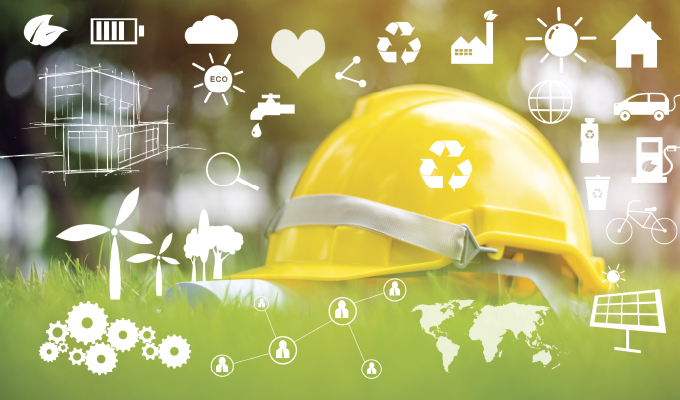The construction industry has a huge stake in the drive to sustainable building. But for all the discussion about net zero and the need to meet environmental, social and corporate governance (ESG) goals in the methods and materials builders use, it’s time to walk the talk.
Anything less is greenwashing, which the public—including insurers—frown on. And the best way around it may be an investment in the green certification process.
The impacts of a changing climate are intensifying daily. The heat this summer has beat 125,000-year-old records. More than 800 wildfires consuming over 24 million acres are raging across Canada, as wildfires destroy more acreage than ever before. Warming oceans fuel more frequent and intense hurricanes.
The construction industry is one of the biggest contributors to global warming: The built environment accounts for 39% of the world’s gross annual carbon emissions, according to the World Economic Forum.
THE GREEN IMPERATIVE
It’s getting easier for the industry to adopt green practices and materials. The options have never been greater.
Take cement, a major contributor to greenhouse gas. The process for making it results in about a twelfth of global carbon dioxide emissions. “Green” cement gets a lot of attention but not a lot of adoption due to performance concerns. Recently, though, a California startup with a new process got third-party certification for its product, aligning it with current standards and boosting the case for commercialization.
Another solution is mass timber. Its renewable nature and negative carbon impact add to its appeal over traditional building materials. Other solutions include recycling road materials for reuse. In Spain, paper ash has been processed to pave a roadway in Valencia. The material looks and acts like concrete but saves up to 75% of concrete’s carbon emissions.
Various tax incentives for green construction materials are a good impetus. The federal Inflation Reduction Act, for example, provides a total of $7,500 in per-unit credits through 2032 for new residential construction that meets energy efficiency guidelines. New Jersey has become the first state to adopt a green concrete tax credit of up to 5% of a project’s total concrete costs when materials with low levels of embodied carbon dioxide emissions are used.
THE GREEN COMMITMENT
There’s a lot of buzz about green construction solutions, but avoiding greenwashing is an issue. Insurers are concerned about the construction industry’s exposures as ESG class action suits generally rise. Law firm Norton Rose Fulbright found 28% of respondents to a survey say they have greater exposure to ESG litigation; 24% are expecting that to grow this year.
In this environment, builders are well-advised to make the investment in green certification. The best-known is LEED, or Leadership in Energy and Environmental Design, but others, like the Green Building Business Certification, are also well-regarded. Another, Energy Star, measures the energy efficiency of everything from appliances to entire office buildings.
By 2022, over 30% of office buildings in the U.S. were LEED-certified. Even more were certified in such cities as Chicago, Minneapolis, and San Francisco.
Undergoing a LEED audit at any one of its four levels creates a variety of returns. LEED-certified properties generate 60% more rent and sell for 60% more per square meter than non-certified buildings. Another benefit: reduced operating costs. The University of California/Davis has saved almost $150,000 a year in electricity and maintenance through its LEED lighting system.
Certification also makes a compelling case to insurers of a construction firm’s sustainability commitment, supporting high operating standards and lower risk of claims. In fact, some insurers may give discounts on premiums because of the certification—helping to offset the LEED certification fees.
A GREEN COMPONENT
Even without a formal certification, firms can take measures to demonstrate their sustainability commitment. It starts with determining their end green goal and the extent of their commitment, even before materials are procured and work starts.
Every stage of a building’s lifecycle, from inception to demolition, should be assessed from a sustainability perspective. Among the things to be considered:
- How building materials are sourced and the environmental standing of the sources
- How the building is constructed and how it functions after completion
- Whether it uses less energy to heat and cool than a traditional building
- How it will be recycled after demolition
CLOSING THOUGHT
Here’s what LEED projects should stand for: Making a reverse contribution to climate change as they enhance human health and well-being. Water resources should be protected and reserved, and so should biodiversity and the ecosystem. Sustainable and regenerative resource cycles should be promoted as a greener economy is built. And ultimately, they should enhance community, social equity, environmental justice and quality of life.
About the Authors:

Phil Casto is senior vice president for Risk Services at HUB International. Casto has extensive experience in the construction, manufacturing, and petrochemical industries. He serves as a resource for the insurance brokerage operations, providing solutions in the areas of risk mitigation, safety, regulatory compliance, and workers’ compensation.

Ray Monteith is senior vice president with global insurance brokerage HUB International’s Risk Services Division. He leads the Organizational Resilience practice and is the Risk Control Services Leader for the Canadian Region. He has more than 25 years of experience in risk consulting and has provided risk evaluations and risk mitigation strategies to a broad range of clients including agencies of federal, provincial, and municipal governments across Canada as well as to various institutions, universities, heavy industry, and major insurance companies.
Modern Contractor Solutions, August 2023
Did you enjoy this article?
Subscribe to the FREE Digital Edition of Modern Contractor Solutions magazine.



